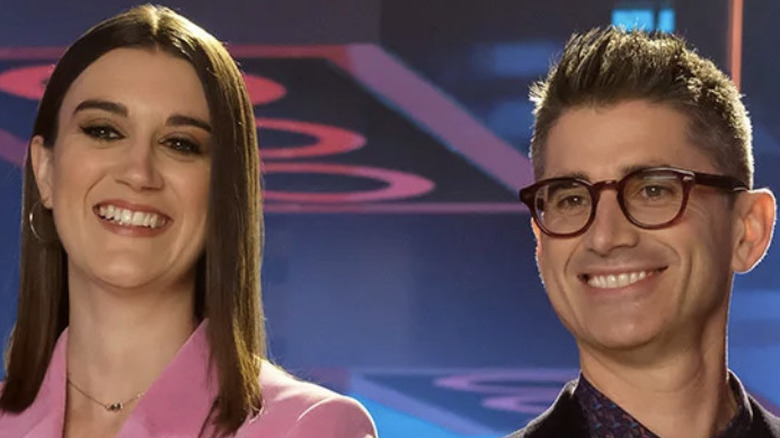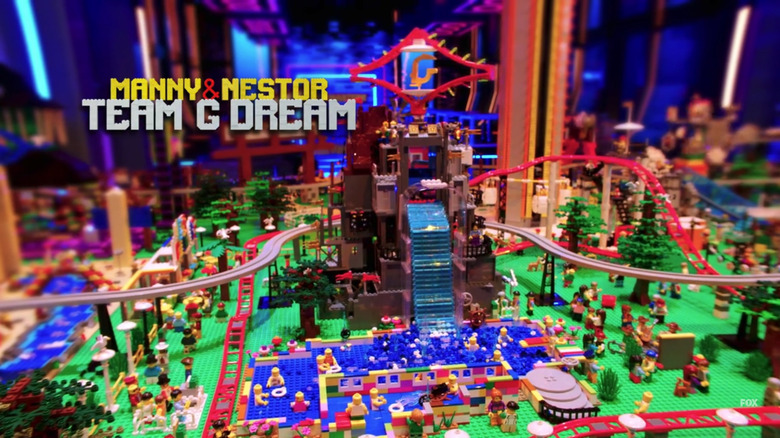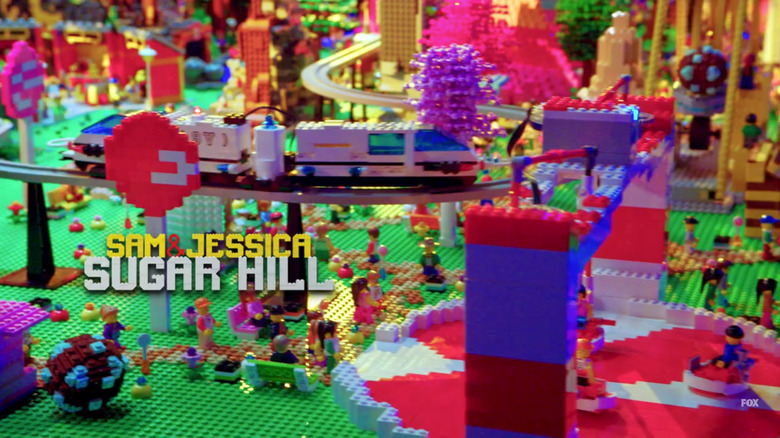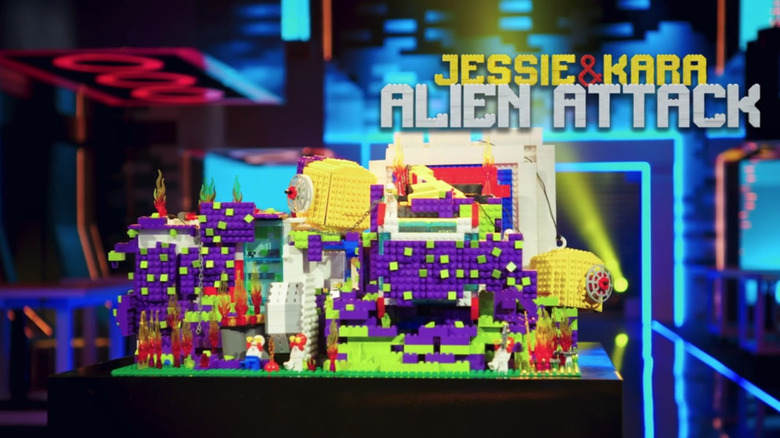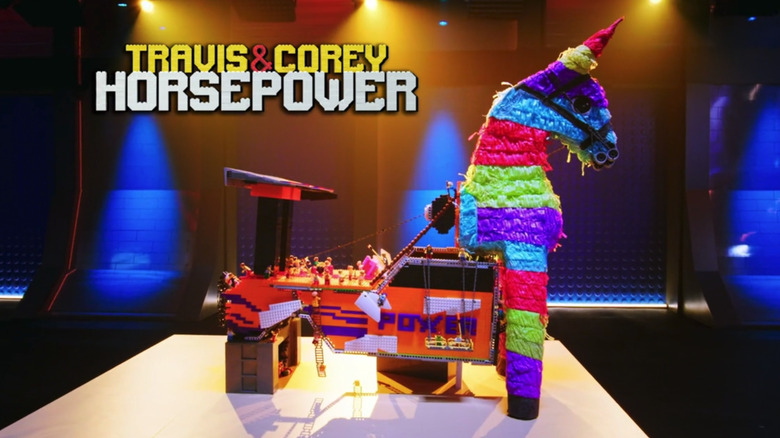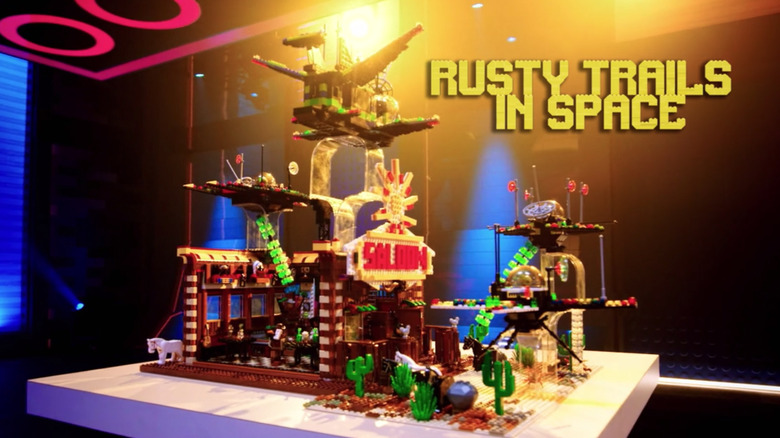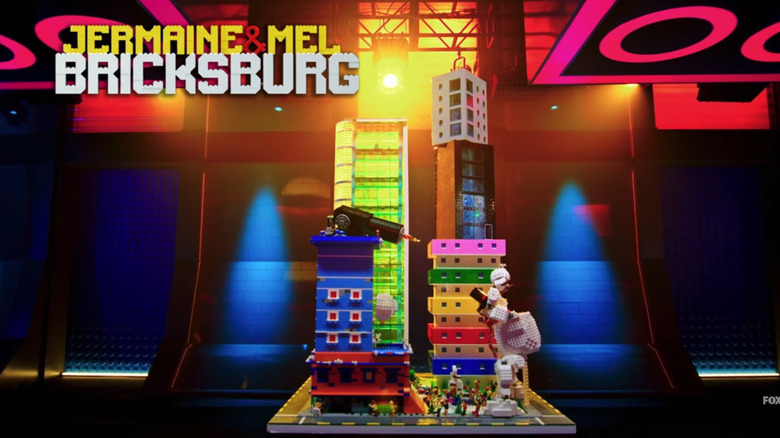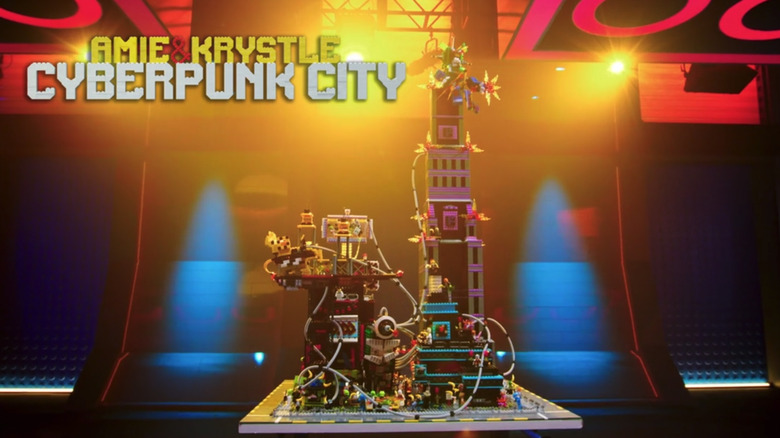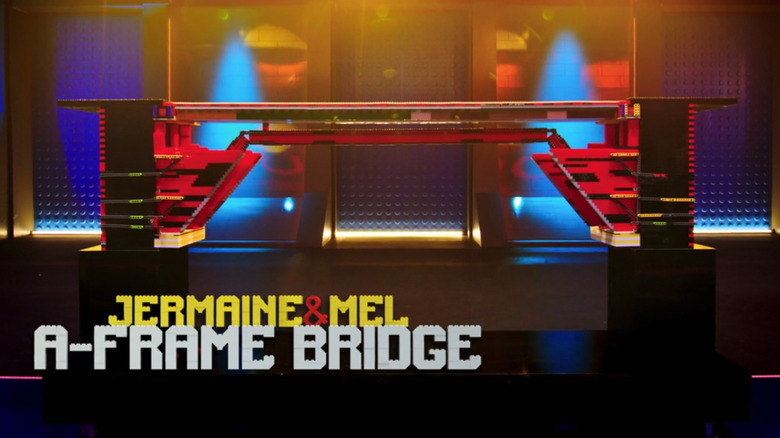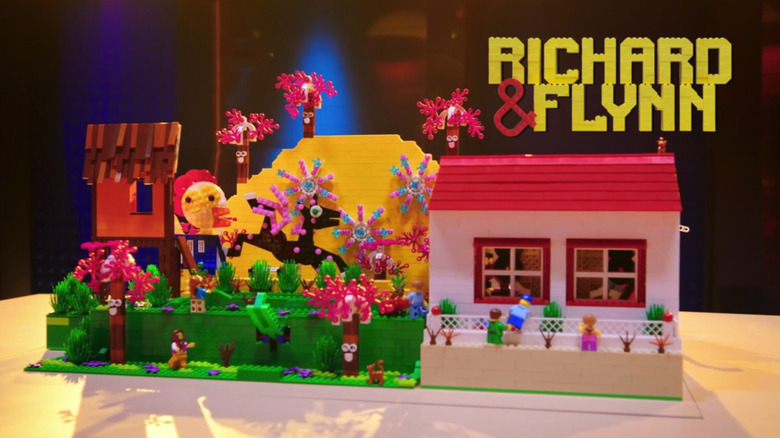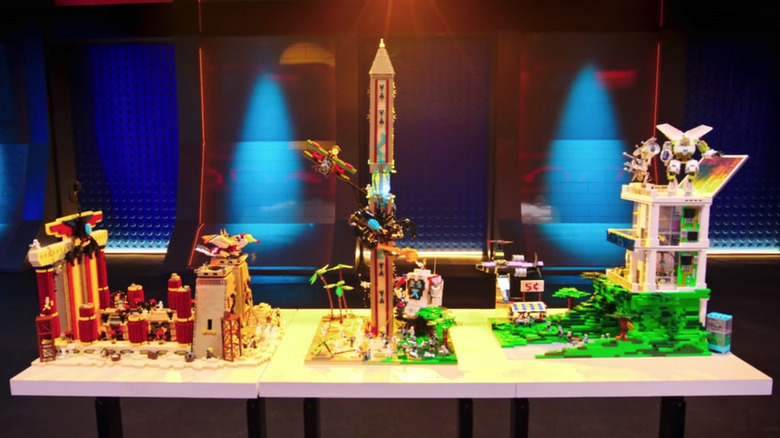The Worst Builds From LEGO Masters Season 1
On "LEGO Masters," some of the most creative minds from the sprawling Adult Fan of LEGO community (AFOL) compete for $100,000 and the ultimate LEGO bragging rights. The first season of the American incarnation of "LEGO Masters" debuted in early 2020, featuring Will Arnett as host, LEGO Brickmasters Jamie Berard and Amy Corbett as judges, and twenty excited LEGO fans working in teams of two in a series of elimination challenges. After ten episodes, only one pair was awarded the title of LEGO Masters, but every builder entered the competition with a rare level of artistic, architectural, and storytelling skill, the result of untold hours of experimentation with the world's favorite building toy.
The conditions of the elimination challenges on "LEGO Masters" were brutal, with teams expected to conceive, design, and construct complex LEGO projects under extreme time constraints. In short, before criticizing any of these builds too harshly, first imagine being on your feet for 15 straight hours while TV cameras hover over your shoulder, the pressure of a six-figure cash prize hanging over your head. It's a lot harder than it looks, and it looks pretty hard. Still, every contest that has a winner must also have losers, and nearly every episode of "LEGO Masters" had at least one build that simply wasn't on the same level as its competition — with that in mind, here are the worst builds from Season 1.
Team 'G' Dream Land (Manny & Nestor, Ep. 1)
One of the most charming qualities of the first season of "LEGO Masters" was the variety of relationships and dynamics on display within the competing teams of two. One team might consist of lifelong friends, while another could be made up of two relative strangers. Among the most endearing of the pairs was Manny Garcia and his father Nestor, who had affection for each other and enthusiasm for the competition coming out of every pore.
Unfortunately, in the first episode, that enthusiasm did not translate into a competitive build. The first was "Dream Park Theme Park," in which each team was asked to contribute one segment of a massive minifig-scale LEGO theme park that would combine all of their work. One of the conditions of the contest was that each team's build had to include one ride that moves. Manny did not initially interpret this rule as meaning that the ride had to move on its own, so he initially included a hand-propelled roller coaster with an incomplete circuit on his landscape. When Brickmaster Jamie advised him that half a roller coaster wasn't going to perform well in the competition, Manny resisted Nestor's pleas to update the build to meet the judges' standards. Eventually (and apparently, offscreen) Manny relented and completed the coaster's circuit, but its drop still did not generate enough momentum to complete a lap on its own. Luckily, "Dream Park" was revealed not to be an elimination challenge.
Sugar Hill (Sam & Jessica, Ep. 1)
The team of Sam Hatmaker and Jessica "Ragzy" Ewud entered "LEGO Masters" with one distinct disadvantage — before the start of the show, they had never built together before. Sam and Jessica had a lot in common, namely both being LEGO artists who had recently committed to making art their full-time job, but their first two builds on the show suffered from their lack of experience together. At first, Sam appeared to have little interest in cooperation, insisting that Jessica work on her sections of their "Sugar Hill" theme park by herself while he worked on his own. It would take two more episodes before the pair learned how to communicate, after which they began to put out increasingly stronger work that would eventually take them to the finals.
Considering how poorly Sam and Jessica got along, it's actually remarkable how cohesive their first build turned out to be. While they may have not collaborated much on any given ride or attraction on the build, they selected a theme for their section of the "Dream Park Theme Park" and each stuck with it, contributing rides and attractions that looked good together. Unfortunately, their build's downfall was the very symbol of their internal team conflict, when a bumper cars ride that Sam had refused to help Jessica finish went out of control and threw one of its cars. No minifigures were seriously injured, but it was enough to land Sam and Jessica in the bottom two.
Alien Attack (Jessie & Kara, Ep. 2)
Most LEGO builds aren't meant to last forever, but serious adult LEGO builders likely aren't accustomed to deliberately smashing their own creations. That's exactly what the competitors on "LEGO Masters'" second episode (and first elimination challenge) were asked to do: Create a LEGO build that was specifically designed to be destroyed.
Before building, each team randomly selected one of three methods by which their next project would be smashed — either dropped off the studio balcony, blown up with explosives, or smashed open with a baseball bat swung by host Will Arnett. Based on the mode of demolition, teams were tasked with creating an outer space-themed build that made its destruction part of the story.
Jessie Rex and Kara Fletcher, "The LEGO Ladies of the Ozarks," drew the baseball bat as the instrument of their build's demise, and set out to create a space scene for Arnett to gleefully destroy. Their build, "Alien Attack," told the story of an astronaut who had absentmindedly dropped the keys to his spaceship, which were picked up by some malicious aliens who'd set their craft ablaze. It was a clever idea (though perhaps better suited to death by explosion than by a swinging club) that did not come together in the final build, which was not only cluttered but structurally unsound. "Alien Attack's" baseboards split apart while the build was being carried to the podium, preemptively breaking the project before the bat could even hit it.
Horsepower (Travis & Corey, Ep. 3)
Brothers Travis and Corey Samuels began building LEGO together when Travis (the younger brother) was fighting childhood leukemia. Now adults with decades of experience building together and an assortment of terrific matching suits, Travis and Corey came to the competition with a strong bond and a sense of showmanship that was a cut above the competition. Despite their energy and skill, they seemed to disappear into the middle of the pack for the first two episodes.
Determined to make a splash this time around, Travis and Corey committed to a very ambitious build for their entry into the "Cut in Half" challenge, in which each team had to replace the missing half of a bisected object. Their object was the front half of a piñata, which inspired them to give the colorful horse the back end of a race car in place of hind legs. They knew from the beginning that this would be a difficult build to complete in 12 hours, but decided it was worth the risk. When it became clear that they would not have enough time to complete their original vision or to pivot to a totally new idea, they attempted to rescue the project by owning that it was a work in progress. The incomplete sports car chassis became a construction site, with worker minifigs placed throughout the build. They valiantly threw themselves into a car salesman-style pitch for the judges, but unfortunately this couldn't save them from elimination.
Rusty Trails in Space (Manny & Nestor, Ep. 4)
After a set of elimination rounds testing the competitors' sculpting skills, the fourth episode challenged teams to create a scene that told a story befitting a provided movie genre. Nestor and Manny Garcia were excited to be assigned Western as their genre, as the father and son bonded over classic Westerns when Manny was growing up. They staged a typical Wild West scene — a hold-up at a dusty saloon — but used an atypical building method, custom-building articulated bodies for their characters rather than using provided minifig parts in order to create a wider variety of poses.
Everything was shaping up for Team G to deliver a strong build until Phil Lord and Chris Miller, directors of "The LEGO Movie," arrived to throw a wrench into their plans. Lord and Miller assigned each team a second genre to mash up with the scenes they'd just spent eight hours building. Manny and Nestor wound up with the particularly challenging combo of Fantasy/Western, and struggled for the next five hours to incorporate some extraordinary element into their story. The results was a bit of a mess — "Rusty Trails in Space" added an alien invasion into the cowboy tableau, but the new elements weren't up to the same building standards. Had the judges made their ruling after the first buzzer, Manny and Nestor would surely have survived another round of the competition — but the twist threw them for a loop, resulting in their elimination.
Bricksburg (Jermaine & Mel, Ep. 5)
When the theme of Episode 5 was revealed to be "Mega City Block," an architecture challenge, the team of Mel Brown and Jermaine Gardner saw an opportunity to finally triumph over rivals Aaron and Christian, who they'd been trading friendly barbs with for the past few rounds. Building skyscrapers was a specialty for Mel, who proposed an ambitious complex of buildings with a winter theme.
Mel focused on building a skyscraper with floor-to-ceiling windows, but the tower took so long to construct that there wasn't enough time remaining to populate the building with minifigures. Beside it stood two smaller, more colorful buildings that they hoped would appeal to Brickmaster Amy, who had asked for something vibrant this round. On the ground floor of the complex, minifigures enjoyed a skating rink and other winter delights, but the buildings themselves didn't seem to reflect their theme particularly well.
The teams completed their city blocks in fourteen hours, but the challenge wasn't over — now they would have an additional four hours to turn their builds into the setting of a battle scene. Mel and Jermaine used this twist to their advantage, besetting Winter Plaza with an attack by a giant abominable snowman. This still wasn't enough to tie their discordant buildings together, however, landing them in the bottom two. This goes to show how fierce the competition had become by this point in the season, as "Bricksburg" is still a pretty impressive build. "Worst" is a relative term, after all.
Cyberpunk City (Amie & Krystle, Ep. 5)
Coming off two straight weeks in the bottom two, the cosplaying pair of engineer Amie Danielle Dansby and artist Krystle Starr looked to turn their luck around with the "Mega City Block" challenge. Both fans of science fiction, Amie and Krystle designed a city in a future dystopia whose jet black buildings would be lit with bright neon highlights. The effect worked brilliantly — even with no actual light-up elements in their build, Amie and Krystle's skyscraper immediately evoked a city at night. The entire block felt like a "Blade Runner" establishing shot, absolutely nailing the initial assignment. If this had been the build that the judges evaluated, you'd find it on a "Best Builds" list.
But much to Amie and Krystle's chagrin, the 14-hour city build was immediately followed by a supplementary challenge, in which they had to place their city under attack by a menace of their own choosing. They attempted to stay on theme, creating a story in which the city is overrun by technology come to life. The addition of robotic monsters to the city didn't do their build any favors, and soon the landscape became so cluttered and confusing that Krystle had difficulty explaining it to the judges. "Cyberpunk City," at one point a contender to win the challenge, instead ended up in the bottom two, and a tearful Brickmaster Amy broke the news to the team that their LEGO adventure had come to an end.
A-Frame Bridge (Jermaine & Mel, Ep. 6)
After narrowly escaping elimination in the "Mega City Block" challenge, Jermaine and Mel were once again aiming to reverse their fortunes with the next contest, "Super-Bridges." In this episode, each team needed to build a LEGO bridge between two pillars, six feet apart. The team whose bridge could support the most weight would be this episode's winner. The two teams whose bridges broke under the least amount of weight would automatically be included in the bottom two, which would be judged purely on their bridge's aesthetic value. The challenge had one final requirement — the roadway for the bridge had to be level with the top of the pillars.
Jermaine took the lead on designing an A-frame bridge that he calculated would hold about 600 pounds. He and Mel built the bridge separate from the pillars, planning to affix it once it was finished. This would prove to be their undoing, as the bridge turned out to be slightly too short to reach all the way from one pillar to the other. Jermaine and Mel attempted to get the bridge up to code but were only able to attach it by setting the bridge slightly below the top of the platform. This was an automatic disqualification, and though their bridge held substantially more weight than Richard and Flynn's, Jermaine and Mel hadn't put much work into making their bridge look pretty. According to the rules, the judges had no choice but to eliminate Jermaine and Mel.
Storybook (Richard & Flynn, Ep. 7)
Married couple Richard Board and Flynn De Marco had a strong start to their "LEGO Masters" season, avoiding the bottom two for five episodes and winning the third challenge, "Cut in Half" with their imaginative and well-crafted "Clockwork Man." However, once the season reached its halfway mark, Richard and Flynn began to struggle to keep up with their competitors. Some of it was hard to blame on them — their entry into the "Mega-Bridges" challenge held only 45lbs, but due to their poor performance in that episode's warm-up challenge they had to begin building 25 minutes after the clock had started running. Visual aesthetics saved them from elimination, but it seemed clear that their time in the competition would soon be running out.
The challenge that finally eliminated Richard and Flynn was "Storybook," in which each team was asked to interpret a bizarre fairy tale written, in part, by a pack of excited young children. Builders would have to decide how they wanted to portray characters like "the Taker-Waker," "the Book Chicken," and "a horse that can do gymnastics." Richard and Flynn took a novel approach to the "Storybook" challenge, adding a motorized conveyer belt to carry the characters through the story in a linear fashion. At this point in the season, however, their flat, pop-up book-style character models simply weren't up to the standard that the judges were expecting. Richard and Flynn became the first team to have won a challenge and later be eliminated.
Programmer & Space Bounty Hunter (Aaron & Christian, Ep. 10)
Aaron Newman and Christian Cowgill were standouts from the start of the competition, when they won the very first challenge with their "Spaceland" theme park. But as the weeks wore on, it became clear that while Aaron and Christian had a lot of technical skill and artistic talent, they sometimes struggled in the storytelling department.
Aaron and Christian made it into the final four, at which point they were assigned to team up with eventual season winners Tyler and Amy for the "Good vs. Evil" challenge. Aaron and Christian were to make a secret headquarters for randomly-selected minifig superheroes, while Tyler and Amy would create a lair for their supervillains. The two teams collaborated on a third build in between them, representing a grand battle between their two sets of characters. The story requirements of this challenge seemed pretty clear, but for some reason Aaron and Christian became hung up on the idea of basing their half of the story — which starred a programmer and a space bounty hunter — around a bake sale, which in no way related to either character. Their contribution to the battle scene, featuring a pair of articulated mechs, was lively and entertaining, but their superhero lair simply paled in comparison to Tyler and Amy's "Temple of the Fire Scorpion," which was named the winner of the challenge.
Aaron and Christian became the last team to be eliminated, while the remaining three teams moved on to the finals.
